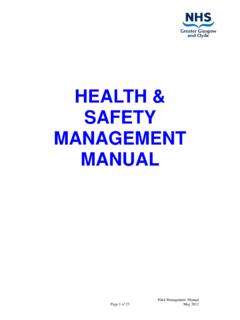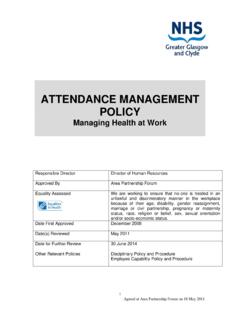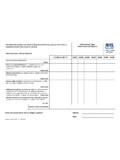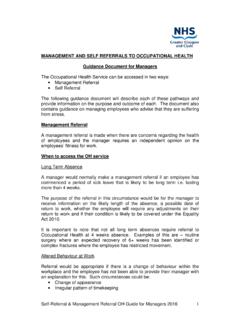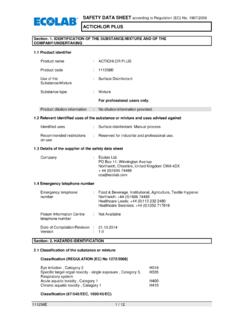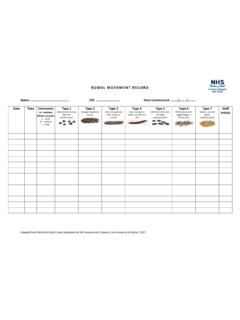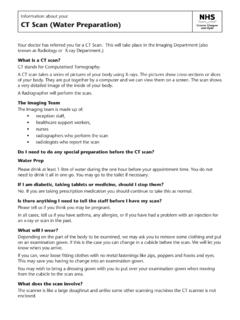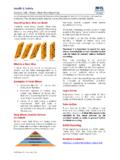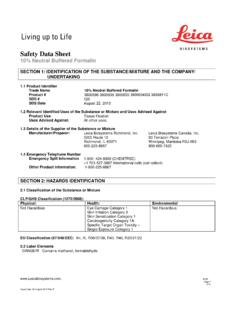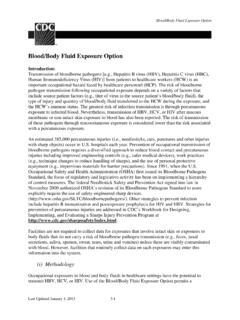Transcription of The Safe Use of Sharps in Healthcare – Guidance for ...
1 Sharps Key Points Guide 2016 Health and Safety Service (Amended May 2017) 1 The Safe Use of Sharps in Healthcare Guidance for managers and staff This guide has been written to highlight the main requirements of the Health and Safety ( Sharps Instruments in Healthcare ) Regulations 2013 (the Sharps Regulations) and how it applies in NHS Greater Glasgow and Clyde. This key points document summaries Guidance and policy documents from a number of sources across NHS GGC. Who does it affect? The Sharps Regulations place an implicit duty on Healthcare employers such as NHS GGC and any contractor working for that employer to co-operate and share information to manage the risks from the use of Sharps . This includes where a person is at risk of a Sharps injury while on the premises of or working under the management and supervision of the Healthcare employer, for example: Facilities staff such as porters, domestics, maintenance personnel, catering etc; Bank nurses and other agency workers contracted to work in NHS GGC; NHS GGC clinical staff working in prisons, schools or other non- Healthcare workplaces; Healthcare workers (HCWs) providing care to people in their homes; and Clinical placements or other workplace training under the management of NHS GGC.
2 Legal Requirements Under existing health and safety law there is the requirement to assess the risks from the use of Sharps , before use and put in place appropriate control measures to manage the risk of Sharps injuries from puncture wounds to cuts from scalpel blades and the associated risks of infection from blood-borne viruses or other biological agents. The NHS GGC Generic Risk Assessment form should be used for this purpose. The Sharps Regulations follow the principles of the hierarchy of control set out in the Control of Substances Hazardous to Health Regulations (COSHH) to eliminate, substitute or otherwise control the risks from the use of Sharps . Information on CoSHH and its application within NHS GGC is available by clicking this link CoSHH Policy and Guidance The recapping of needles or re-sheathing of other types of Sharps are a known cause of injury in the Healthcare setting during the process where the sharp is held in one hand and the cap / sheath is held in the other.
3 This practice must not be carried out unless in itself it is required to prevent another risk and would be subject to risk assessment. Devices such as needle blocks can be used to hold and remove the needle cap and allow safe one-handed recapping. Any process where re-capping must take place for clinical reasons should be risk assessed. The risk assessment must detail the safe system of work in place to minimise the risk of needlestick injury. Sharps Key Points Guide 2016 Health and Safety Service (Amended May 2017) 2 Hierarchy of Control Eliminate / avoid the use of Sharps Sharps must only be used where they are required and where a safer Sharps device is not available. Examples include: suture needles and scalpel blades. Where patients self administering medication may bring in their own Sharps to hospital, then this issue will have to be considered in the risk assessment.
4 HCWs must not administer the medication using the patient s own Sharps devices where the patient has been assessed as competent to carry out this function for themselves. Patients in ward areas should be informed that where possible they self administer in the presence of the HCW so that they can be observed disposing of the Sharps appropriately into the Sharps container. This will minimise risk to other staff and patients. An internal Safety Action Notice on Risk of needlestick injury from patient self administration pens was circulated in March 2016. Patients may also be undertaking supplementary blood glucose monitoring with their own equipment and should be issued with hospital single use lancets for this and have access to a Sharps container.
5 Substitute the sharp with a safer alternative Traditional, unprotected Sharps must be substituted with a safer sharp where reasonably practicable to do so, where the technology exists. Safer Sharps are those which incorporate features or mechanisms to prevent or minimise the risk of injury and may include devices that are self activating or operator activated and slide or pivot to cover the needle after use. Self activating devices are preferential to operator activated as it does not rely on the worker to control the safety mechanism of the device. The needlestick Injury Reduction Group and Practice Development co-ordinate the trialling of safer Sharps devices for use in NHS GGC and must consider the following factors for any safety devices: The device does not compromise patient care; The reliability of the device; The HCW must be able to maintain control over the procedure; Other safety hazards or sources of blood exposure that use of the device may introduce; Ease of use; Is the safety mechanism design suitable for the application?
6 The following are relevant: o if activation of the safety mechanism is straightforward, it is more likely to be used; o if the safety mechanism is integral to the device ( not a separate accessory) it cannot be lost or misplaced; o for many uses a single-handed or automatic activation will be preferable; o an audible, tactile or visual signal that the safety mechanism has been correctly activated is helpful to the user; and o the safety mechanism is not effective if it is easily reversible. NHSGGC will continue to source and make available safer Sharps equipment for use within our diverse clinical settings, as part of our current provision the undernoted equipment are the most commonly used devices. Sharps Key Points Guide 2016 Health and Safety Service (Amended May 2017) 3 SOL-CARE Safety Needle Vacuette Safety Blood Collection Set + Luer Adapter Vacuette Safety blood collection Tube Holder Safety Hypodermic Syringe (Sol-Care Braun) Vacuette Safety Blood Collection (Bio-One - Greiner / Abbott) Vacuette Safety Blood Collection Tube Holder (Quickshield - Greiner / Abbott ) Otherwise control the risk If safety devices cannot be used, the risk must be controlled through the process of risk assessment, safe systems of work, personal protective equipment (PPE) and the information, instruction, training and supervision provided to the HCW.
7 If a safety device is available but cannot be used for clinical reasons, this must be risk assessed and documented within the Health and Safety management Manual for the area, in addition a copy of the risk assessment should be sent to the Service Health and Safety Practitioner who will forward to the needlestick Injury Reduction Group for their information and possible dissemination to other clinical areas in order to share means of learning or good practice. It should be noted that in terms of preventing a Sharps injury PPE such as nitrile gloves will not provide adequate protection from a sharp . Vaccination is limited against Blood Borne Viruses and only Hepatitis B vaccination is available. All HCWs who have the potential to be exposed to blood and body fluids in NHS GGC are offered and strongly advised to have a Hepatitis B vaccination / check on their immune status.
8 Sharps Containers In NHS GGC a number of Sharps incidents are due to inappropriate disposal after use therefore Sharps containers must be: readily available and placed within the area of use such as wall mounted brackets or near patient disposal system (NPDS) trays for the HCW; available at the bedside for self-administering patients; readily available and appropriate for the HCW in the community to safely dispose of the sharp . Sharps containers must be used appropriately as directed in the Waste management Policy and Guidance and in relation to any Infection Prevention and Control requirements. Points of note are: All Sharps should be handled as little as possible and must be disposed of safely in the appropriate container by the person using it at the time & at the point of use; The temporary closure mechanism must be opened prior to the disposal of the sharp ; Sharps Key Points Guide 2016 Health and Safety Service (Amended May 2017) 4 Sharps containers must not be filled above the manufacturers marked line; Sharps containers should be dated on assembly and sealed and disposed of when the manufacturer s marked line is reached or within a set period identified through local risk assessment, whichever is soonest; Hands / fingers must not be placed in the Sharps container to deposit or remove items.
9 Be aware of the colour coding of Sharps containers depending on the category of waste. Options above showing , 2L, 9L and 24L Sharps containers. Below is the 3L with NPDS tray. Information, Instruction and Training Information during induction and refresher training must be provided which covers: the correct use of safer Sharps ; safe use and disposal of Sharps ; what to do in the event of a Sharps injury / near miss; and Sharps Key Points Guide 2016 Health and Safety Service (Amended May 2017) 5 arrangements for Health Surveillance and other procedures. Training in the use of new Sharps products is initially provided by the manufacturer, then via Practice Development during Clinical Skills Update Sessions. For most devices a cascade system of demonstration is in place.
10 2 e-learning modules are available via learnPro entitled NES: Prevention- management of Occupational Exposure , and GGC Occupational and non-occupational exposure . An example risk assessment is available via the Health and Safety Service website which includes information on Sharps . This can be amended to suit the needs of your Service area. Example Sharps Risk Assessment Arrangements in the event of a Sharps injury These arrangements are set out in detail in the Occupational Health Guidance In brief staff should: Apply first aid to the wound by encouraging it to bleed, washing with warm soapy water and applying a dry clean dressing. Advise the manager of the incident / adverse event so that assessment forms A & B can be completed to establish the risk status of the source blood and an adverse event file can be completed.

